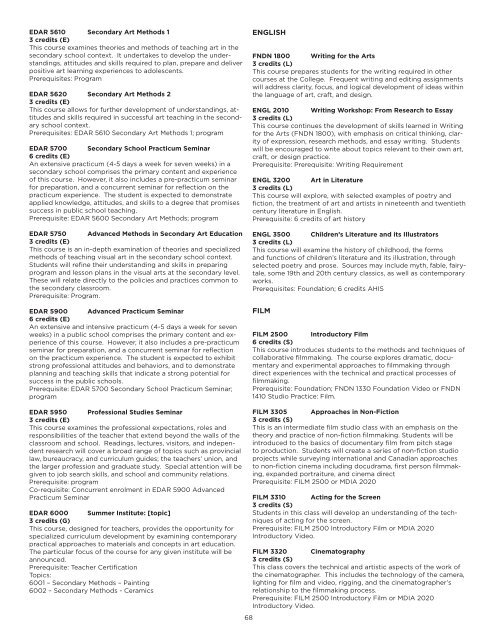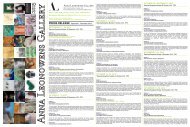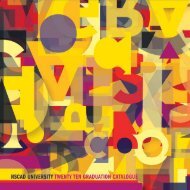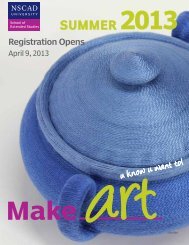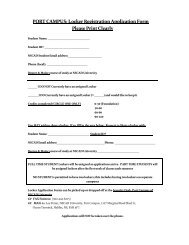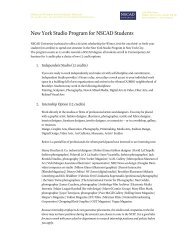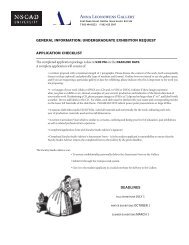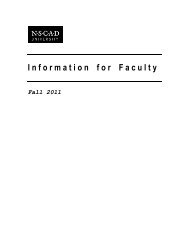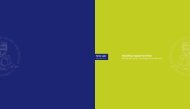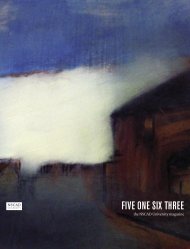NSCAD.Calendar_February 2.FINAL.indd - Nova Scotia College of ...
NSCAD.Calendar_February 2.FINAL.indd - Nova Scotia College of ...
NSCAD.Calendar_February 2.FINAL.indd - Nova Scotia College of ...
You also want an ePaper? Increase the reach of your titles
YUMPU automatically turns print PDFs into web optimized ePapers that Google loves.
EDAR 5610 Secondary Art Methods 1<br />
3 credits (E)<br />
This course examines theories and methods <strong>of</strong> teaching art in the<br />
secondary school context. It undertakes to develop the understandings,<br />
attitudes and skills required to plan, prepare and deliver<br />
positive art learning experiences to adolescents.<br />
Prerequisites: Program<br />
EDAR 5620 Secondary Art Methods 2<br />
3 credits (E)<br />
This course allows for further development <strong>of</strong> understandings, attitudes<br />
and skills required in successful art teaching in the secondary<br />
school context.<br />
Prerequisites: EDAR 5610 Secondary Art Methods 1; program<br />
EDAR 5700 Secondary School Practicum Seminar<br />
6 credits (E)<br />
An extensive practicum (4-5 days a week for seven weeks) in a<br />
secondary school comprises the primary content and experience<br />
<strong>of</strong> this course. However, it also includes a pre-practicum seminar<br />
for preparation, and a concurrent seminar for refl ection on the<br />
practicum experience. The student is expected to demonstrate<br />
applied knowledge, attitudes, and skills to a degree that promises<br />
success in public school teaching.<br />
Prerequisite: EDAR 5600 Secondary Art Methods; program<br />
EDAR 5750 Advanced Methods in Secondary Art Education<br />
3 credits (E)<br />
This course is an in-depth examination <strong>of</strong> theories and specialized<br />
methods <strong>of</strong> teaching visual art in the secondary school context.<br />
Students will refi ne their understanding and skills in preparing<br />
program and lesson plans in the visual arts at the secondary level.<br />
These will relate directly to the policies and practices common to<br />
the secondary classroom.<br />
Prerequisite: Program.<br />
EDAR 5900 Advanced Practicum Seminar<br />
6 credits (E)<br />
An extensive and intensive practicum (4-5 days a week for seven<br />
weeks) in a public school comprises the primary content and experience<br />
<strong>of</strong> this course. However, it also includes a pre-practicum<br />
seminar for preparation, and a concurrent seminar for refl ection<br />
on the practicum experience. The student is expected to exhibit<br />
strong pr<strong>of</strong>essional attitudes and behaviors, and to demonstrate<br />
planning and teaching skills that indicate a strong potential for<br />
success in the public schools.<br />
Prerequisite: EDAR 5700 Secondary School Practicum Seminar;<br />
program<br />
EDAR 5950 Pr<strong>of</strong>essional Studies Seminar<br />
3 credits (E)<br />
This course examines the pr<strong>of</strong>essional expectations, roles and<br />
responsibilities <strong>of</strong> the teacher that extend beyond the walls <strong>of</strong> the<br />
classroom and school. Readings, lectures, visitors, and independent<br />
research will cover a broad range <strong>of</strong> topics such as provincial<br />
law, bureaucracy, and curriculum guides; the teachers’ union, and<br />
the larger pr<strong>of</strong>ession and graduate study. Special attention will be<br />
given to job search skills, and school and community relations.<br />
Prerequisite: program<br />
Co-requisite: Concurrent enrolment in EDAR 5900 Advanced<br />
Practicum Seminar<br />
EDAR 6000 Summer Institute: [topic]<br />
3 credits (G)<br />
This course, designed for teachers, provides the opportunity for<br />
specialized curriculum development by examining contemporary<br />
practical approaches to materials and concepts in art education.<br />
The particular focus <strong>of</strong> the course for any given institute will be<br />
announced.<br />
Prerequisite: Teacher Certifi cation<br />
Topics:<br />
6001 – Secondary Methods – Painting<br />
6002 – Secondary Methods - Ceramics<br />
68<br />
ENGLISH<br />
FNDN 1800 Writing for the Arts<br />
3 credits (L)<br />
This course prepares students for the writing required in other<br />
courses at the <strong>College</strong>. Frequent writing and editing assignments<br />
will address clarity, focus, and logical development <strong>of</strong> ideas within<br />
the language <strong>of</strong> art, craft, and design.<br />
ENGL 2010 Writing Workshop: From Research to Essay<br />
3 credits (L)<br />
This course continues the development <strong>of</strong> skills learned in Writing<br />
for the Arts (FNDN 1800), with emphasis on critical thinking, clarity<br />
<strong>of</strong> expression, research methods, and essay writing. Students<br />
will be encouraged to write about topics relevant to their own art,<br />
craft, or design practice.<br />
Prerequisite: Prerequisite: Writing Requirement<br />
ENGL 3200 Art in Literature<br />
3 credits (L)<br />
This course will explore, with selected examples <strong>of</strong> poetry and<br />
fi ction, the treatment <strong>of</strong> art and artists in nineteenth and twentieth<br />
century literature in English.<br />
Prerequisite: 6 credits <strong>of</strong> art history<br />
ENGL 3500 Children’s Literature and its Illustrators<br />
3 credits (L)<br />
This course will examine the history <strong>of</strong> childhood, the forms<br />
and functions <strong>of</strong> children’s literature and its illustration, through<br />
selected poetry and prose. Sources may include myth, fable, fairytale,<br />
some 19th and 20th century classics, as well as contemporary<br />
works.<br />
Prerequisites: Foundation; 6 credits AHIS<br />
FILM<br />
FILM 2500 Introductory Film<br />
6 credits (S)<br />
This course introduces students to the methods and techniques <strong>of</strong><br />
collaborative fi lmmaking. The course explores dramatic, documentary<br />
and experimental approaches to fi lmmaking through<br />
direct experiences with the technical and practical processes <strong>of</strong><br />
fi lmmaking.<br />
Prerequisite: Foundation; FNDN 1330 Foundation Video or FNDN<br />
1410 Studio Practice: Film.<br />
FILM 3305 Approaches in Non-Fiction<br />
3 credits (S)<br />
This is an intermediate fi lm studio class with an emphasis on the<br />
theory and practice <strong>of</strong> non-fi ction fi lmmaking. Students will be<br />
introduced to the basics <strong>of</strong> documentary fi lm from pitch stage<br />
to production. Students will create a series <strong>of</strong> non-fi ction studio<br />
projects while surveying international and Canadian approaches<br />
to non-fi ction cinema including docudrama, fi rst person fi lmmaking,<br />
expanded portraiture, and cinema direct<br />
Prerequisite: FILM 2500 or MDIA 2020<br />
FILM 3310 Acting for the Screen<br />
3 credits (S)<br />
Students in this class will develop an understanding <strong>of</strong> the techniques<br />
<strong>of</strong> acting for the screen.<br />
Prerequisite: FILM 2500 Introductory Film or MDIA 2020<br />
Introductory Video.<br />
FILM 3320 Cinematography<br />
3 credits (S)<br />
This class covers the technical and artistic aspects <strong>of</strong> the work <strong>of</strong><br />
the cinematographer. This includes the technology <strong>of</strong> the camera,<br />
lighting for fi lm and video, rigging, and the cinematographer’s<br />
relationship to the fi lmmaking process.<br />
Prerequisite: FILM 2500 Introductory Film or MDIA 2020<br />
Introductory Video.


